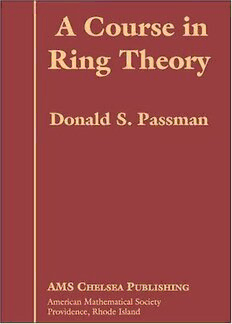
A Course in Ring Theory PDF
Preview A Course in Ring Theory
A COURSE IN RING THEORY A COURSE IN NG THEORY DONALDS. PASSMAN AMS CHELSEA PUBLISHING American Mathematical Society • Providence, Rhode Island 2000 Mathematics Subject Classification. Primary 16-01; Secondary 16-02, 19-02. For additional information and updates on this book, visit www.ams.org/bookpages/c hel-348 Library of Congress Cataloging-in-Publication Data Passman, Donald S., 1940- A course in ring theory / Donald S. Passman. p.cm. Originally published: Pacific Grove, Calif. : Wadsworth & Brooks/Cole Advanced Books & Software, cl991. Includes bibliographical references and index. ISBN 0-8218-3680-3 (alk. paper) 1. Rings (Algebra) I. Title. QA247.P28 2004 5121.4-dc22 2004054403 Copying and reprinting. Individual readers of this publication, and nonprofit libraries acting for them, are permitted to make fair use of the material, such as to copy a chapter for use in teaching or research. Permission is granted to quote brief passages from this publication in reviews, provided the customary acknowledgment of the source is given. Republication, systematic copying, or multiple reproduction of any material in this publication is permitted only under license from the American Mathematical Society. Requests for such permission should be addressed to the Acquisitions Department, American Mathematical Society, 201 Charles Street, Providence, Rhode Island 02904-2294, USA. Requests can also be ma.de by e-mail to reprint-permission©ams. org. © 2004 by Donald S. Passman. All rights reserved. Printed in the United States of America. @ The paper used in this book is acid-free and falls within the guidelines established to ensure permanence and durability. Visit the AMS home page at http: I /www.ams.org/ 10987654321 090807060504 Preface These are the somewhat expanded notes from a course in ring theory that I have been giving for about ten years. The nature of the course has evolved over time; I am now relatively happy with the choices made. In this book; we use the underlying theme of projective and injective modules to touch upon various aspects of commutative and noncommuta tive ring theory. In particular, we highlight and prove a number of rather major results. In Part I, "Projective Modules," we begin with basic module theory and a brief study of free and projective modules. We then consider Wed derburn rings and, more general, Artinian rings. Next, come hereditary rings and, in particular, Dedekind domains. With this, we are ready for the key concepts of the projective dimension of a module and of the global dimension of a ring. Finally, we introduce the tensor product of modules and we determine all projective modules of local rings. In Part II, "Polynomial Rings," we study these rings in a mildly noncommutative setting. We start with skew polynomial rings, determine their global dimension and then compute their Grothendieck and projec tive Grothendieck groups. In particular, we obtain the Hilbert Syzygy Theorem in the commutative case. Next, we offer an affirmative solution to the Serre· Conjecture and, in fact, we determine all the projective mod ules of these polynomial rings. Finally, we use generic flatness to prove the Hilbert Nullstellensatz for almost commutative algebras. In Part III, "Injective Modules," we start with injective analogs of projective results, but quickly move on to intrinsically injective proper ties. In particular, we study the maximal ring of quotients and use it to prove the existence of the classical ring of quotients. We then obtain the v Preface Goldie Theorems, study uniform dimension, and characterize the injective modules of Noetherian rings. We close with basic properties of reduced rank and determine when Artinian quotient rings exist. This book contains numerous exercises for the student and ends with a list of suggested additional reading. In closing, I would like to express my thanks to a number of people. First, to my friends Larry Levy, Martin Lorenz, Jim Osterburg, and Lance Small for their input and helpful criticism. Second, to Mike Slattery, who attended the first course I gave on this subject and who offered me a copy of his class notes. I suspect he will be rather surprised at the direction ii:t which this course evolved. Third, to Irving Kaplansky, who introduced noncomputational homological algebra. These notes are written in the spirit of his book "Fields and Rings." Finally, my love and appreciation to my family Marj, Barbara, and Jon for their enthusiastic support of this project. I couldn't have done it without them. Donald S. Passman Madison, Wisconsin November, 1990 Contents I. Projective Modules 1. Modules and Homomorphisms 3 2. Projective Modules 13 3. Completely Reducible Modules 23 4. Wedderburn Rings 33 5. Artinian Rings 44 6. Hereditary Rings 56 7. Dedekind Domains 64 8. Projective Dimension 74 9. Tensor Products 84 10. Local Rings 95 II. Polynomial Rings 11. Skew Polynomial Rings 105 12. Grothendieck Groups 115 13. Graded Rings and Modules 124 14. Induced Modules 133 15. Syzygy Theorem 142 16. Patching Theorem 152 17. Serre Conjecture 161 18. Big Projectives 171 19. Generic Flatness 180 20. Nulls.tellensatz 190 vii viii Contents III. Injective Modules 21. Injective Modules 203 22. Injective Dimension 213 23. Essential Extensions 223 24. Maximal Ring of Quotients 233 25. Classical Ring of Quotients ~42 26. Gol4ie Rings 252 27. Uniform Dimension 262 28. Uniform Injective Modules 2.73 29. Reduced Rank 284 Suggested Additional Reading 295 Index 297 Part I Projective Modules
